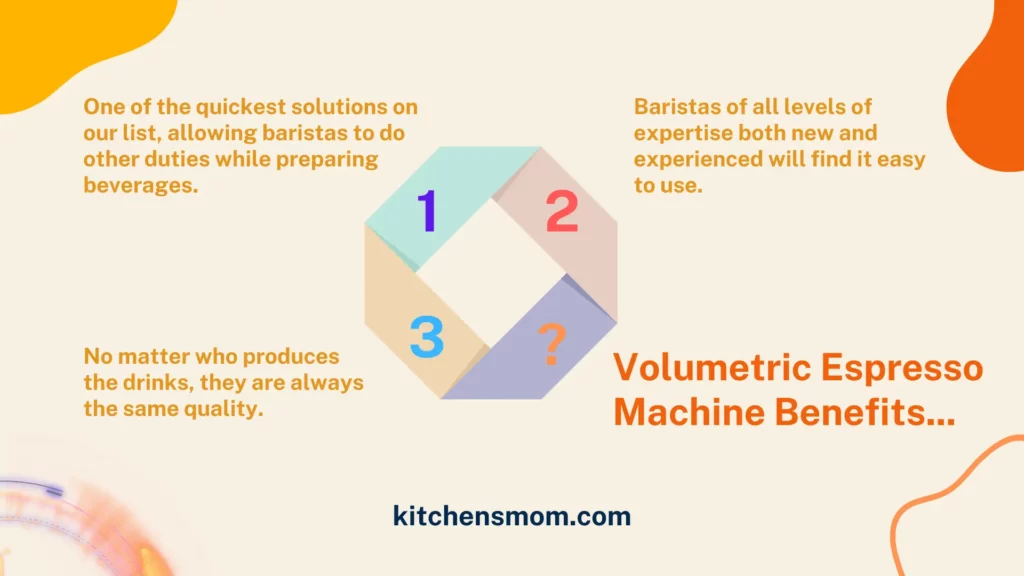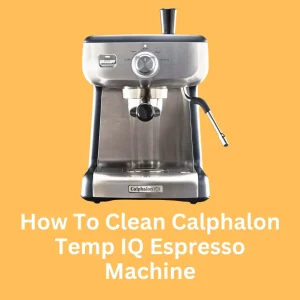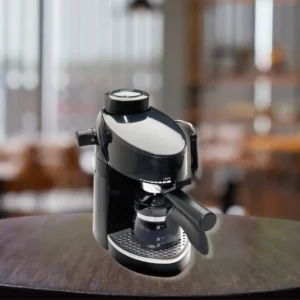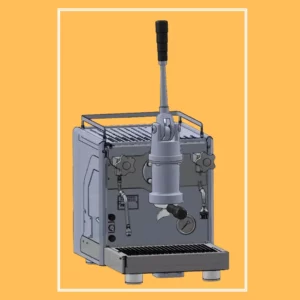Affiliate Disclaimer
As an Amazon Associate, I earn from qualifying purchases. It supports the website. So, Thank you. ❤️
“Automatic espresso machines are another name for volumetric machines. These devices pre-program the amount of water that will be utilized for each shot. This ensures that each espresso shot has the appropriate quantity of water.”
They are dependable, and consistent, and enable the barista to carry out other chores while the espresso shot is being taken. There is also less need for a highly skilled person, which saves money on both training and salaries.
Volumetric Espresso Machines: What Are They?
With volumetric espresso machines, the volume of water can be set up ahead of time. So, each espresso shot gets just the right volume of water to make a nice cup of coffee each time.
Auto volumetric espresso machines use a circulate meter to keep track of how much water is delivered. To set it up, you need to run a practice shot while the system keeps track of the flow. To repeat the quantity of water delivered in successive shoots, all you have to do is press a single button.
A lot of business machines can measure the amount of liquid they hold. In cafes, objective brew ratios and extraction returns were more stable when the shot was cut instantly after a certain volume of water was dispensed instead of by time or by looking at the stability and color of the stream.
How Do Espresso Machines Work Automatically?
Most espresso machines aren’t that difficult to operate, but understanding how they function can help you get the most out of your machine. I have tried to discuss key factors here to give you a better understanding of the inner workings of these devices and how they function.
To make espresso you start with water that’s free of pollutants and has an excellent taste. Then you add the espresso grinds and mix it all together.
The water will reside in the water reservoir until it is required for the next cup of coffee. Smaller machines that don’t need to make hundreds of cups per day often do this.
While the water is in the reservoir, you can change it in some way. For the best espresso, the water has to be just right. As you will see, water is a key part of making great espresso!
There are several advantages to using an appliance that may be directly connected to the main supply of drinking water in an industrial or commercial situation.
With machines that connect directly to the water supply, you’ll need both a water softener and a filtration system. This is the best choice for businesses that need to make a lot of espressos every day.
It takes a while for the water to pass through the machine before it’s retrieved into a cup and transformed into a delicious beverage.
Benefits Of Using A Volumetric Espresso Machine

Using a volumetric machine, you may make a shot with a pre-programmed amount of water added. To brew a shot, the barista presses a preprogrammed brew button, and the machine runs until it recognizes that the water has been poured in accordance with the predetermined quantity. The brewing process is then put to an end.
Customers may expect consistent espresso shots since the quality of the espresso shot isn’t reliant on human mistakes.
Automatic espresso machines have the added benefit of being much easier to train new employees on.
It’s possible for even the most seasoned baristas to convert to an analog system on certain automated machines.
Here are some reasons why you might want an automatic espresso machine:
Some disadvantages of automated machines:
What Is A Volumetric Pump On An Espresso Machine?
All espresso machines use some kind of hydraulic force to create the pressures needed to pull espresso out of the beans. Most modern espresso coffee machines build up this pressure with the help of an electric pump inside or outside the machine. Related things about the volumetric pump on an espresso machine are given below:
Pump Machine And Lever Machine
This pump machine replaced the old lever machine. With the lever machine, the barista had to pull a lever to get the right amount of pressure. This is where the phrase “pulling a shot” comes from.
With the advent of electric pumps, not only are shots simpler to pull off, but the pressure is also more reliable. As a consequence of this, the extraction process for espresso has become more uniform.
Rotary Vane Pump
A rotary vane pump is the type of pump found in most commercial-grade espresso machines. This pump has a rotary vane pump head made of brass and an electric motor that turns the pump.
A clamp or bolted flange holds the brass pump head to the electric motor. The manufacturer and age of the machine affect where this pump goes, so in some cases, the pump assembly will be on the outside of the machine.
Using An Internal Pump Assembly
However, the majority of modern machines use an internal pump assembly, and in certain instances, the electric motor will be water-cooled. This kind of pump generated the most consistent group head pressure.
To get the correct group head pressure, the pump must be adjusted. A screw on the brass part of the assembly allows for fine-tuning. Increasing pressure with a clockwise adjustment and decreasing pressure with a counterclockwise adjustment.
This adjustment also takes into account the inlet pressure, so when you put our machine together, make sure the inlet pressure is less than two bars. If the pressure coming in is higher than this, you should lower it with a Watts-type water regulator.
Overly Active Pressure Gauges
Overly active pressure gauges are a solid indicator that a rotary vane pump is failing. When you draw a shot, keep an eye on the gauge; if it’s jerking about, you may need a new pump.
Your pump may also be broken if the pressure at the group head is low and it can’t be adjusted. Most rotary pumps break because they don’t have enough water. Even if the pump runs out of water for just a second, it could cause damage.
Importance Of Pressurized Water Source
As long as you utilize a pressurized water source, you should never use a non-pressurized water tank to supply your espresso machine with water.
The correct operation of rotary vane pumps is contingent upon the presence of a pressured water supply. Operate an external diaphragm pump if you need to use your machine when a pressured water supply is not accessible, such as in a catering environment or at a trade fair.
Several companies make these, and they make sure that you give your machine the right pressure when you turn it on. If you have a water filtration system, make sure it’s in good shape because, over time, the water pressure can drop.
Filtration Systems
Filtration systems can easily get clogged up with the trash you’re trying to get out of the water. If a filter slows down the flow of water, it could also hurt the water pump.
High-end home and semi-commercial espresso machines often use the vibratory pump as the second most prevalent pump type. In most cases, vibratory pumps are installed within the machine and are non-repairable.
In a low-volume context, vibratory pumps may and can offer a dependable source of pressure to the group head.
Though self-priming vibratory pumps are able to take water from a non-pressurized source, vibratory pumps cannot withstand repeated operation because the pump body temperature increases rapidly and might cause early failure.
If a water regulator is fitted on the outlet side of the pump, these pumps are not adjustable. Rotary vane pumps are better suited for high-volume espresso extraction because of their sturdier construction.
Things You May Want To Know
Volumetric machines are those that are able to inject a predetermined quantity of water when a shot is dripped. Brew time is set to run until water has been poured, which is determined by the barista pressing a brew button. After then, the brewing process is finished.
Those who like delicious espresso may select the pressure range of 7 to 15 BARs. High-quality coffee machines have a pressure of 15 BARs. The 15 BARs may be handy, providing the machine with adequate range for an initial kick of 10-11 BARs, which then drops to 9-10 BARs throughout the brewing process.
You should backflush every 1-3 weeks with detergent, but it’s worth it every day or two if you use water. At home, you don’t need to flush your toilet with detergent every day, unlike at a café. We recommend using a grouphead brush if you want to clean the grouphead often.
Pro Advice:
- Espresso coffee machines may explode if the pressure builds up too much without venting.
- If the espresso machine’s overpressure valve is defective, the machine is more likely to explode.
- Only responsible adults should use the machine. It should be kept out of reach of children and kept on a stable, heat-resistant surface.
- Unplug the device and contact the manufacturer if you detect a peculiar odor or sparking.
- Always switch off the equipment when not in use.
Kinel’s Observation
Automated or volumetric espresso machines may ease the process of dealing with large crowds. To fully balance the advantages and disadvantages of a volumetric espresso machine, you’ll need to learn about what is a volumetric espresso machine and the uses of it. Automated espresso machines provide benefits that outweigh their limitations for many organizations.
An automatic espresso machine does everything by itself when it comes to making espresso. Once it’s turned on, the machine will automatically add the right volume of water to the espresso-based on settings that the manufacturer or sometimes baristas want.



